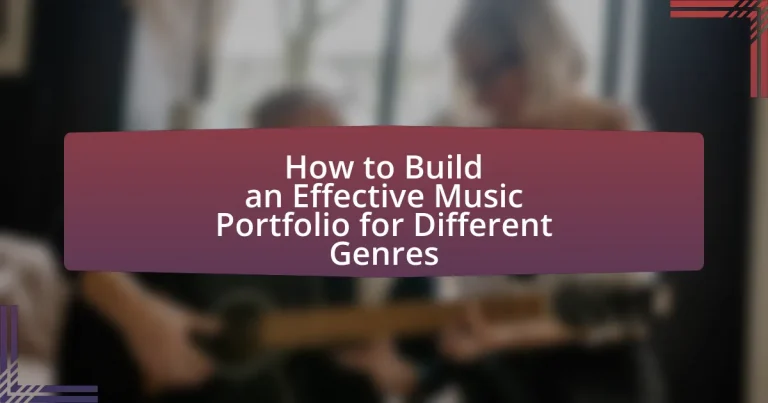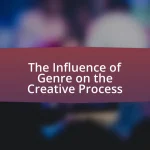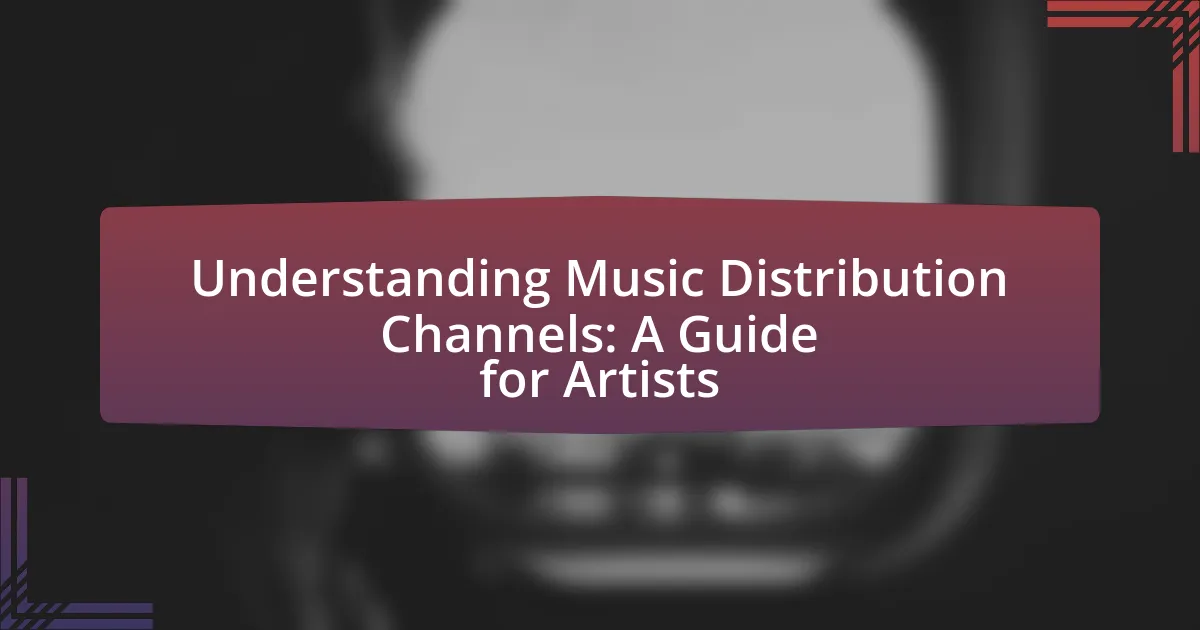An effective music portfolio is a curated collection that showcases a musician’s skills, versatility, and unique style, tailored to specific genres. This article outlines the essential elements of a music portfolio, including high-quality recordings, a professional biography, and visual components, while emphasizing the importance of genre-specific requirements in shaping content and presentation. It also discusses common mistakes to avoid, the significance of feedback, and best practices for maintaining a relevant portfolio. By understanding how to build and adapt a music portfolio for different genres, musicians can enhance their marketability and increase opportunities within the competitive music industry.
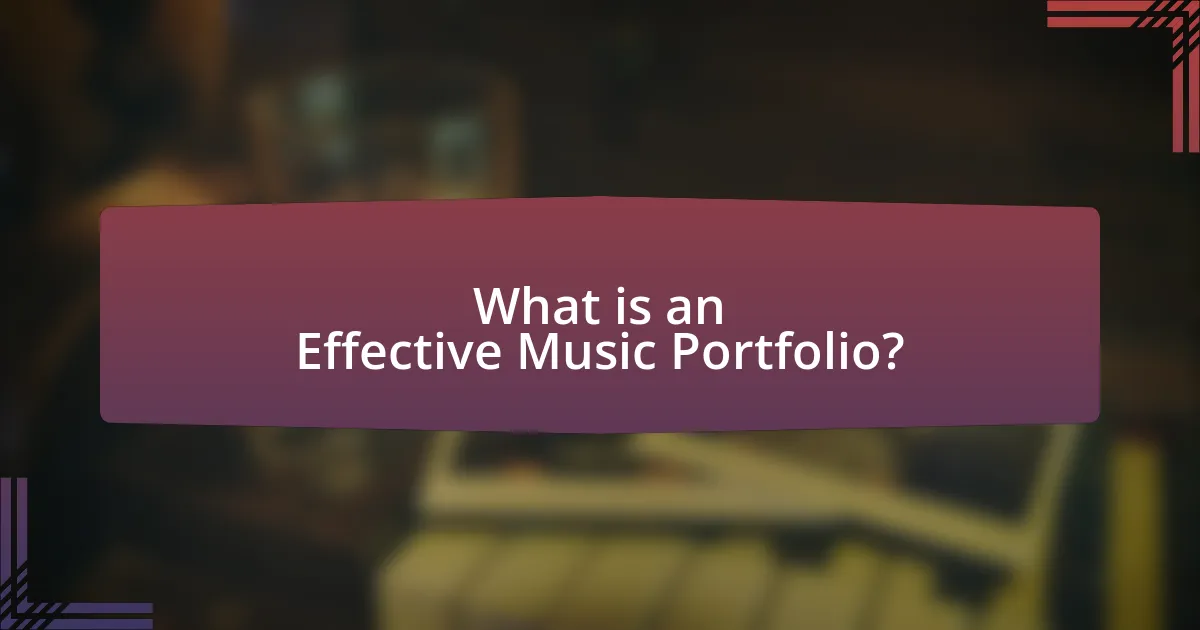
What is an Effective Music Portfolio?
An effective music portfolio is a curated collection of a musician’s work that showcases their skills, versatility, and unique style. It typically includes high-quality recordings of original compositions or performances, a well-written biography, and relevant visual elements such as photos or videos. The portfolio should be tailored to the specific genre the musician is targeting, demonstrating an understanding of genre conventions and audience expectations. For instance, a portfolio for a classical musician may emphasize technical proficiency and formal training, while a portfolio for a pop artist might focus on catchy melodies and engaging visuals. This targeted approach enhances the musician’s appeal to potential collaborators, venues, and audiences, ultimately increasing their chances of success in the competitive music industry.
How does a music portfolio differ across genres?
A music portfolio differs across genres primarily in its content and presentation style. For instance, a classical music portfolio typically emphasizes sheet music, recordings of live performances, and detailed program notes, showcasing technical proficiency and interpretative skills. In contrast, a pop music portfolio often includes professionally produced tracks, music videos, and social media engagement metrics, highlighting commercial appeal and audience reach. Additionally, genres like jazz may focus on improvisational skills and collaborations, featuring live jam session recordings and testimonials from other musicians. This genre-specific approach ensures that the portfolio effectively communicates the artist’s strengths and aligns with industry expectations, as evidenced by the varying requirements set by record labels and performance venues across different musical styles.
What are the essential elements of a music portfolio?
The essential elements of a music portfolio include a diverse selection of original compositions, high-quality recordings, performance videos, a professional biography, and a list of collaborations or notable performances. Original compositions showcase creativity and musical style, while high-quality recordings demonstrate technical proficiency and production quality. Performance videos provide visual evidence of stage presence and audience engagement. A professional biography offers context about the artist’s background, influences, and achievements, and a list of collaborations or notable performances highlights credibility and experience in the music industry. These components collectively present a comprehensive view of an artist’s capabilities and artistic identity.
How do genre-specific requirements influence portfolio content?
Genre-specific requirements significantly influence portfolio content by dictating the types of works and presentation styles that are most relevant to each genre. For instance, a classical music portfolio typically emphasizes technical proficiency and formal training, showcasing pieces that highlight these skills, while a pop music portfolio may prioritize originality and commercial appeal, featuring catchy hooks and relatable lyrics. This alignment ensures that the portfolio resonates with the expectations of industry professionals and audiences within that genre, ultimately enhancing the artist’s marketability and relevance.
Why is a music portfolio important for musicians?
A music portfolio is important for musicians because it serves as a comprehensive showcase of their skills, creativity, and versatility. This collection of work allows musicians to present their best pieces, demonstrating their unique style and artistic identity to potential clients, collaborators, and industry professionals. A well-curated portfolio can significantly enhance a musician’s chances of securing gigs, attracting record labels, and gaining a following. Research indicates that musicians with professional portfolios are more likely to be hired for performances and collaborations, as it provides tangible evidence of their capabilities and experience.
How does a portfolio showcase a musician’s skills?
A portfolio showcases a musician’s skills by presenting a curated collection of their work, including recordings, performances, and compositions. This collection allows potential clients, collaborators, and audiences to assess the musician’s technical abilities, creativity, and style. For example, a portfolio may include audio samples that demonstrate proficiency in various genres, live performance videos that highlight stage presence, and written scores that reflect compositional skills. By providing tangible evidence of a musician’s capabilities, a well-structured portfolio effectively communicates their artistic identity and professional experience.
What role does a portfolio play in securing opportunities?
A portfolio plays a crucial role in securing opportunities by showcasing an individual’s skills, creativity, and experience in a tangible format. In the music industry, a well-curated portfolio allows artists to present their work to potential employers, collaborators, and clients, effectively demonstrating their unique style and capabilities. Research indicates that 85% of hiring managers consider portfolios essential for evaluating candidates in creative fields, highlighting their importance in making a strong first impression and differentiating oneself from competitors.
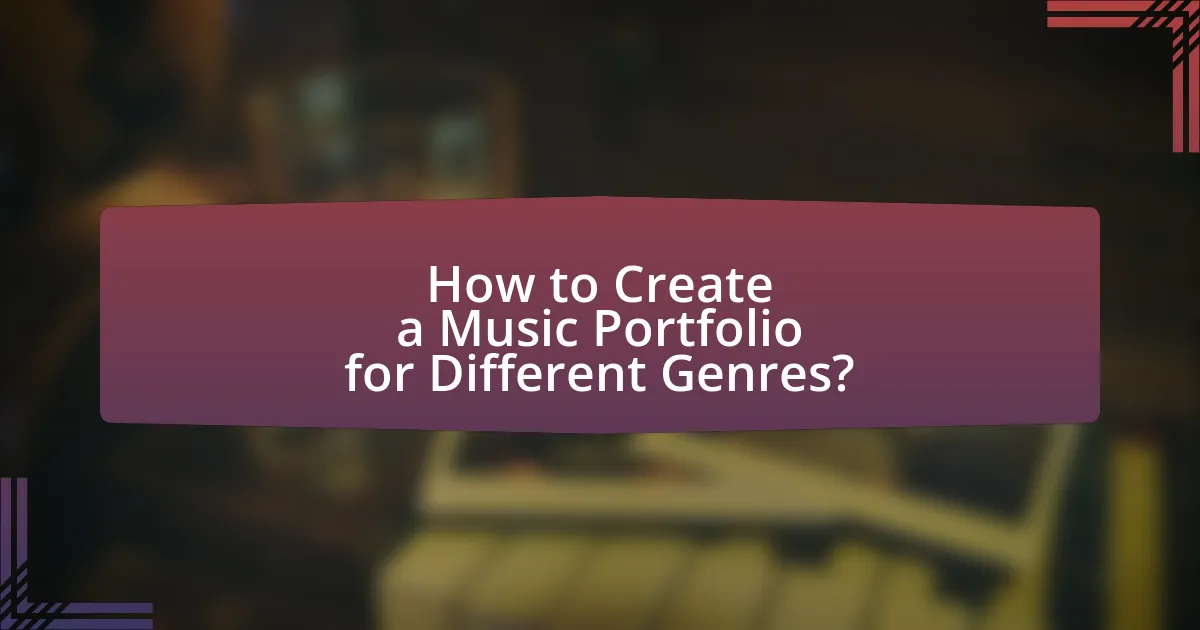
How to Create a Music Portfolio for Different Genres?
To create a music portfolio for different genres, start by selecting representative works that showcase your versatility across those genres. Include a variety of tracks that highlight your skills, such as songwriting, performance, and production, ensuring each piece aligns with the specific genre’s characteristics. For example, if you are including pop, rock, and jazz, choose songs that exemplify the unique elements of each genre, such as catchy hooks for pop, guitar riffs for rock, and improvisation for jazz.
Additionally, provide context for each track by including a brief description of your role in the creation process, the inspiration behind the music, and any relevant collaborations. This approach not only demonstrates your range but also your understanding of each genre’s nuances.
Finally, ensure your portfolio is visually appealing and easy to navigate, possibly using a website or digital platform that allows for audio samples, videos, and written content. This method effectively showcases your talent and adaptability, making it easier for potential clients or collaborators to assess your work across different musical styles.
What steps should be taken to build a genre-specific portfolio?
To build a genre-specific portfolio, identify the genre you want to focus on and curate your work to reflect its unique characteristics. Start by selecting your best pieces that align with the genre’s style, ensuring they showcase your skills and creativity effectively. Next, include a variety of formats, such as recordings, sheet music, and live performance videos, to demonstrate versatility within the genre. Additionally, seek feedback from peers or mentors in that genre to refine your selections and presentation. Finally, regularly update your portfolio with new works and remove outdated pieces to keep it relevant and engaging.
How do you select the right pieces for your portfolio?
To select the right pieces for your portfolio, evaluate your strengths and the genres you want to represent. Focus on showcasing a diverse range of skills and styles that align with your artistic identity. For instance, if you excel in both classical and contemporary music, include pieces from each genre to demonstrate versatility. Additionally, consider the audience and purpose of your portfolio; for example, if applying for a specific opportunity, tailor your selection to highlight relevant works. Research indicates that a well-curated portfolio can significantly increase chances of success in auditions and job applications, as it reflects both competence and personal style.
What formats are best for presenting your music portfolio?
The best formats for presenting your music portfolio include digital platforms, physical press kits, and streaming services. Digital platforms such as websites and social media allow for easy sharing and accessibility, showcasing audio, video, and written content. Physical press kits provide tangible materials like CDs, bios, and promotional photos, which can be effective for in-person meetings or events. Streaming services like SoundCloud and Spotify enable artists to reach wider audiences and provide instant access to their music. These formats are widely recognized in the industry for their effectiveness in showcasing an artist’s work and engaging potential listeners or industry professionals.
How can you tailor your portfolio for specific audiences?
To tailor your portfolio for specific audiences, focus on showcasing work that aligns with their preferences and expectations. For instance, if targeting a pop music audience, include upbeat tracks and vibrant visuals that reflect current trends in the genre. Research indicates that 70% of music listeners prefer artists who resonate with their personal tastes, highlighting the importance of audience alignment. Additionally, customizing your portfolio by incorporating relevant themes, instrumentation, and production styles can enhance engagement and appeal, ensuring that your work speaks directly to the audience’s interests.
What considerations should be made for industry professionals?
Industry professionals should consider the diversity and relevance of the music portfolio to effectively showcase their skills across different genres. A well-rounded portfolio should include a variety of works that highlight versatility, such as original compositions, collaborations, and genre-specific projects. Additionally, professionals must ensure that their portfolio is easily accessible and presented in a visually appealing format, as studies indicate that a professional presentation can significantly impact first impressions in the music industry. Furthermore, including high-quality recordings and detailed descriptions of each piece can enhance the portfolio’s effectiveness, as clarity and quality are crucial for attracting potential clients or collaborators.
How do you adapt your portfolio for different performance settings?
To adapt your portfolio for different performance settings, you should tailor your selection of works to match the specific audience and venue characteristics. For instance, in an intimate acoustic setting, prioritize showcasing softer, more personal pieces that highlight vocal and instrumental nuances, while in a larger venue, include more dynamic and energetic tracks that can fill the space and engage a broader audience. Research indicates that understanding the venue’s acoustics and audience demographics can significantly enhance performance effectiveness, as evidenced by studies showing that tailored setlists lead to higher audience engagement and satisfaction.
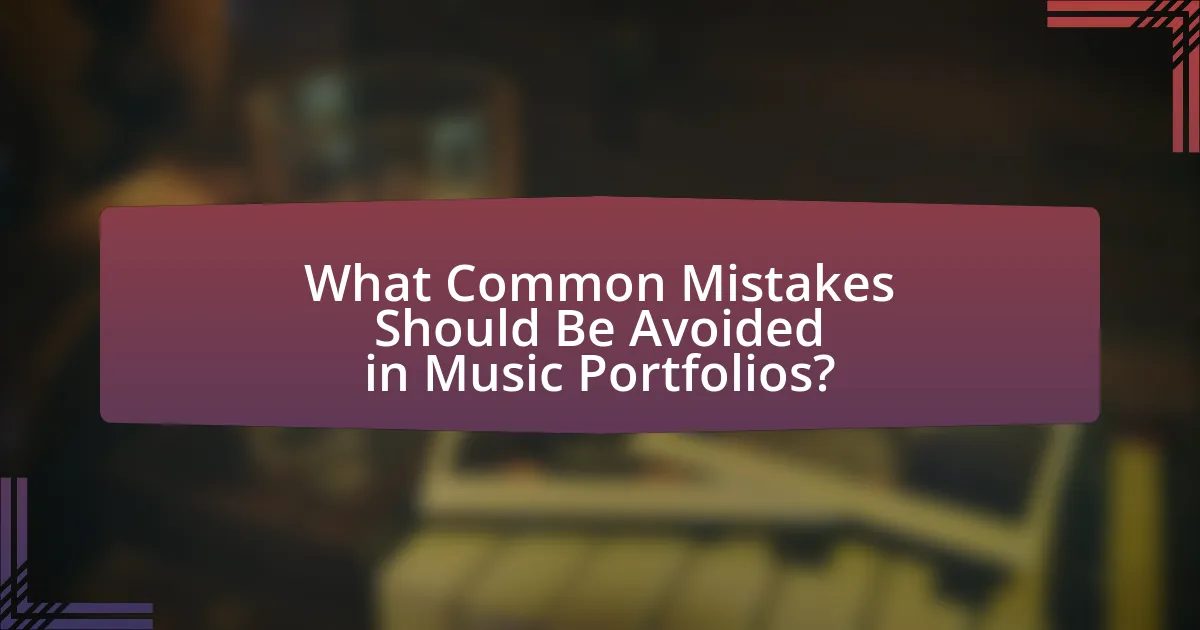
What Common Mistakes Should Be Avoided in Music Portfolios?
Common mistakes to avoid in music portfolios include lack of focus, poor presentation, and insufficient variety. A music portfolio should clearly showcase the artist’s unique style and strengths; failing to do so can confuse potential listeners or employers. Additionally, a cluttered or unprofessional layout detracts from the quality of the work presented, making it harder for reviewers to engage with the content. Lastly, including only a narrow range of work limits opportunities for showcasing versatility, which is crucial in appealing to diverse audiences and genres. These mistakes can hinder an artist’s chances of making a strong impression in a competitive industry.
What are the pitfalls of a poorly organized portfolio?
A poorly organized portfolio can lead to confusion and misrepresentation of an artist’s work. When a portfolio lacks structure, it becomes difficult for potential clients or collaborators to navigate and assess the artist’s skills and style. This disorganization can result in missed opportunities, as decision-makers may overlook key pieces or fail to grasp the artist’s range and capabilities. Furthermore, a chaotic presentation can diminish professionalism, leading to negative perceptions about the artist’s commitment and attention to detail. Research indicates that clear organization enhances user experience and engagement, which is crucial in creative fields where first impressions significantly impact career advancement.
How can lack of genre focus weaken your portfolio?
A lack of genre focus can weaken your portfolio by diluting your artistic identity and making it harder for potential clients or collaborators to understand your strengths. When a portfolio showcases a wide variety of genres without a clear specialization, it may lead to confusion about the creator’s expertise and unique style. Research indicates that musicians who concentrate on a specific genre tend to attract a more dedicated audience and better opportunities, as they can position themselves as experts in that area. For instance, a study by the Berklee College of Music found that artists with a defined genre focus are more likely to receive targeted marketing and promotional support, enhancing their visibility in a competitive industry.
What are the consequences of outdated or irrelevant content?
Outdated or irrelevant content can significantly harm a music portfolio by diminishing its credibility and relevance to potential clients or audiences. When content does not reflect current trends or accurate information, it can lead to a loss of engagement, as audiences may perceive the portfolio as unprofessional or out of touch. Additionally, search engines prioritize fresh and relevant content, meaning that outdated material can negatively impact search rankings, reducing visibility and discoverability. This can ultimately result in fewer opportunities for collaboration, performance, or sales, as potential clients may choose to engage with more current and relevant portfolios.
How can feedback improve your music portfolio?
Feedback can significantly enhance your music portfolio by providing insights into strengths and areas for improvement. Constructive criticism from peers, mentors, or audiences helps identify what resonates well and what may need refinement, allowing for targeted adjustments. For instance, a study by the University of California found that musicians who actively sought feedback improved their skills and creativity, leading to more polished and diverse portfolios. This iterative process of receiving and implementing feedback fosters growth, ultimately resulting in a more compelling and effective music portfolio.
What sources of feedback should you consider?
Consider feedback from industry professionals, peers, and audience members. Industry professionals, such as producers and music critics, provide expert insights that can enhance the quality of your portfolio. Peers, including fellow musicians, can offer constructive criticism based on their experiences and knowledge of the genre. Audience feedback, gathered through live performances or social media, reflects listener preferences and can guide your artistic direction. Collectively, these sources of feedback contribute to a well-rounded understanding of your music’s impact and areas for improvement.
How do you implement constructive criticism effectively?
To implement constructive criticism effectively, provide specific, actionable feedback that focuses on the work rather than the individual. This approach encourages improvement and fosters a positive environment. For instance, instead of saying “This song is bad,” specify what elements could be enhanced, such as “The melody could be more engaging by incorporating a stronger hook.” Research indicates that constructive criticism leads to better performance outcomes, as it helps individuals understand areas for growth while maintaining their motivation (Stone & Heen, 2014, “Thanks for the Feedback”).
What are the best practices for maintaining a music portfolio?
The best practices for maintaining a music portfolio include regularly updating content, showcasing diverse skills, and ensuring high-quality presentation. Regular updates keep the portfolio relevant and reflect the artist’s growth, while showcasing diverse skills demonstrates versatility across different genres. High-quality presentation, including professional recordings and visually appealing layouts, enhances the portfolio’s impact. According to a survey by Sonicbids, 70% of music professionals believe that a well-maintained portfolio significantly increases an artist’s chances of getting gigs.
How often should you update your portfolio?
You should update your portfolio at least every six months. Regular updates ensure that your portfolio reflects your most current work and skills, which is crucial in the fast-evolving music industry. Additionally, research indicates that artists who frequently refresh their portfolios are more likely to attract new opportunities and collaborations, as they showcase their growth and adaptability.
What strategies can help keep your portfolio relevant?
To keep your music portfolio relevant, regularly update it with new works that reflect current trends and your evolving style. This involves actively creating and showcasing diverse pieces that resonate with contemporary audiences, as well as revisiting and refining older works to align with your current artistic vision. Additionally, engaging with industry developments, such as emerging genres and technologies, ensures your portfolio remains aligned with market demands. For instance, incorporating digital formats or multimedia elements can enhance appeal, as evidenced by the rise of platforms like SoundCloud and Bandcamp, which have transformed how music is shared and consumed.
